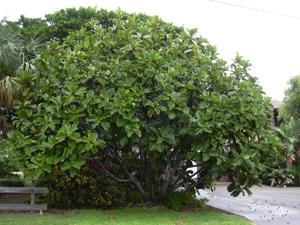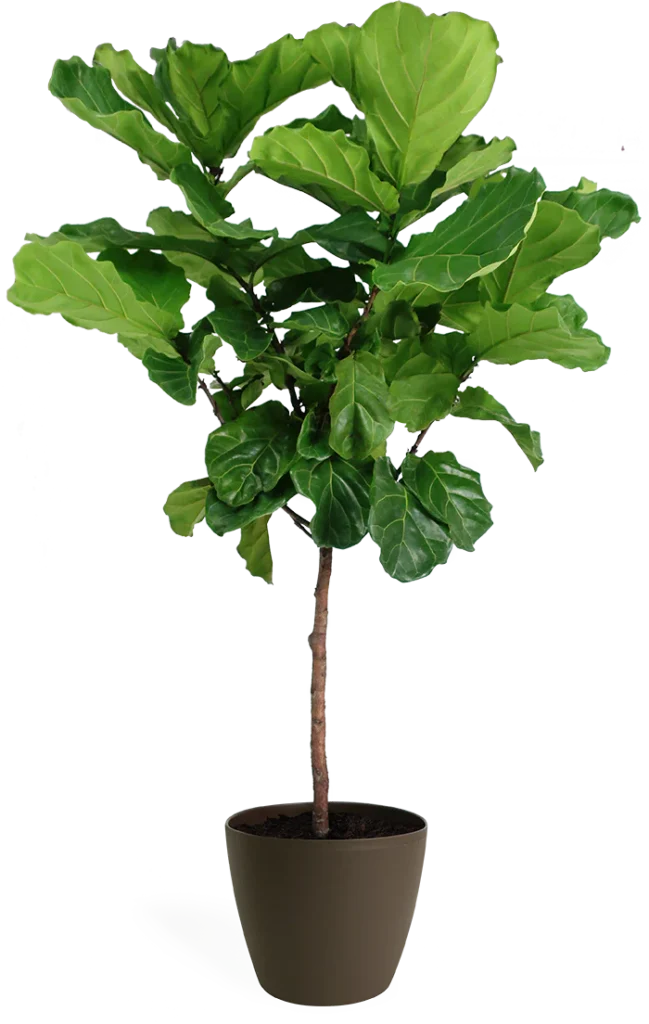The Best Light Conditions For Ficus Lyrata: What You Need To Know”

Introduction to Ficus Lyrata
The Ficus Lyrata, known as the Fiddle Leaf Fig. It has become a staple in modern interior design and plant enthusiast circles. Its large, violin-shaped leaves bring elegance to any space it inhabits.
What is a Fiddle Leaf Fig?
Ficus Lyrata is a species of fig tree that belongs to the mulberry and fig family Moraceae. In its natural habitat, it can grow up to 12-15 meters (40-50 feet) tall. But, when cultivated as a houseplant, it reaches a more manageable height of 2-3 meters (6-10 feet).
The most distinguishing feature of the Fiddle Leaf Fig is its foliage. The leaves are:
- Large, often measuring 30-45 cm (12-18 inches) long and 20-30 cm (8-12 inches) wide
- Shaped like a violin or fiddle, hence the common name
- Glossy and dark green
- Veined, adding to their visual appeal
Origin and Natural Habitat
Ficus Lyrata is native to the tropical regions of West Africa:
- Sierra Leone
- Cameroon
- Gabon
In its natural habitat, the Fiddle Leaf Fig thrives in:
- Lowland tropical rainforests
- Areas with high humidity and consistent temperatures
- Shaded environments, often growing as an understory tree
Why Fiddle Leaf Figs are Popular Houseplants
The Ficus Lyrata has surged in popularity for several reasons:
- Dramatic Appearance: The large, glossy leaves make a bold statement in any room.
- Architectural Quality: Its upright growth and distinctive leaf shape lend a sculptural element.
- Versatility: While it can grow quite tall, it’s adaptable to various sizes. It can fit different spaces.
- Air-Purifying Properties: Fiddle Leaf Figs can help improve indoor air quality.
- Instagram-Worthy: Its photogenic nature has made it a favorite among interior designers.
Fiddle Leaf Fig Appearance and Characteristics
The Ficus Lyrata, or Fiddle Leaf Fig, is known for its striking appearance.
Leaf Shape and Size
The leaves of the Fiddle Leaf Fig are its most distinctive feature:
- Shape: The leaves are shaped like a fiddle or lyre. They have a broad upper part that narrows to a slender “waist” before widening again at the base.
- Size: Mature leaves can grow large, ranging from 25-45 cm (10-18 inches) in length and 15-30 cm (6-12 inches) in width.
- Texture: The leaves have a leathery texture and are thick and sturdy.
- Color: They display a rich, deep green color that can add a vibrant pop to any interior space.
- Veination: Prominent veins run throughout the leaf, adding to its visual interest.
Plant Structure
Ficus Lyrata has a distinctive growth pattern and structure:
- Growth Habit: It grows as a single trunk with leaves sprouting from the stem.
- Branching: In its natural habitat, it can develop many branches. It often maintains a single stem unless pruned to encourage branching.
- Height: In indoor settings, Fiddle Leaf Figs can reach 2-3 meters (6-10 feet). They are excellent statement plants for rooms with high ceilings.
- Canopy: The large leaves cluster at the top of the stem, creating a top-heavy appearance.
Growth Rate and Mature Size
Understanding the growth patterns of Ficus Lyrata is crucial for long-term care:
- Growth Rate: Fiddle Leaf Figs are moderate to fast growers under optimal conditions. During the growing season, they produce a new leaf every 4-6 weeks.
- Mature Indoor Size: They can reach impressive heights indoors. Most are between 1.2-1.8 meters (4-6 feet) tall through regular pruning.
- Lifespan: A Fiddle Leaf Fig can live for many years, as a houseplant.
Key Growth Factors:
- Light conditions
- Watering schedule
- Nutrition
- Pot size
- Environmental stability
It’s important to note that growth can be slower in less-than-ideal conditions. The plant may go through periods of dormancy, especially during winter.
Unique Characteristics
Some interesting facts about Ficus Lyrata:
- Aerial Roots: In their natural habitat, they can develop aerial roots. They support the plant and absorb moisture from the air.
- Latex Sap: Like other figs, Fiddle Leaf Figs produce a milky sap when cut or damaged. This sap can be irritating to skin and toxic if ingested.
- Fruit Production: They can produce small, inedible fig-like fruits.
- Air-Purifying: Ficus Lyrata can help remove indoor air pollutants.
Caring for Your Fiddle Leaf Fig

Proper care is essential for keeping your Ficus Lyrata healthy and vibrant.
Light Requirements
Fiddle Leaf Figs are known for their specific light needs. Light impacts their growth and health.
Optimal Light Conditions
- Bright, Indirect Light: Fiddle Leaf Figs thrive in bright, indirect light. This mimics their natural understory habitat in tropical forests.
- Duration: Aim for 6-8 hours of bright, indirect light daily.
- Best Locations:
- Near east or west-facing windows
- A few feet away from south-facing windows (with some protection from direct sunlight)
- In a well-lit room with large windows
Signs of Too Much or Too Little Light
Too Much Light:
- Leaves turning yellow or pale
- Brown, crispy edges on leaves
- Leaf sunburn (white or brown patches)
Too Little Light:
- Slow or stunted growth
- Smaller new leaves
- Leaves dropping, especially lower ones
- Elongated stems reaching towards light sources
Pro Tip: Rotate your Ficus Lyrata every few weeks to ensure even growth. Rotating it prevents it from leaning towards the light source.
Watering Your Ficus Lyrata
Proper watering is crucial for Fiddle Leaf Fig care. These plants are sensitive to both overwatering and underwatering.
Watering Frequency and Technique
- Frequency: Water when the top 1-2 inches of soil feel dry. This translates to watering once every 7-10 days. It can vary based on environmental factors.
- Technique:
- Water until water runs out of the drainage holes
- Ensure the pot has proper drainage to prevent water from sitting in the soil
- Use room temperature water to avoid shocking the plant
- Seasonal Adjustments:
- Reduce watering frequency in winter when growth slows
- Increase during active growth periods in spring and summer
Signs of Overwatering and Underwatering
Overwatering Signs:
- Yellowing leaves, especially lower ones
- Brown spots surrounded by yellow halos
- Soggy or mushy stems
- Mold on soil surface
Underwatering Signs:
- Drooping or wilting leaves
- Crispy, brown leaf edges
- Leaves curling inward
- Slow growth or leaf drop
Water Quality Considerations
- Type of Water: Fiddle Leaf Figs prefer filtered or distilled water. Tap water can contain chemicals that may build up in the soil over time.
- Temperature: Use room temperature water to avoid shocking the plant’s roots.
- pH Level: Aim for acidic to neutral water (pH 6.0-7.0) for optimal nutrient absorption.
Watering Tip: Consider using a moisture meter for more accurate watering. Avoid the guesswork in determining when to water your Ficus Lyrata.
Soil and Potting
The right soil mix and proper potting are fundamental to the health of your Fiddle Leaf Fig.
Best Soil Mix for Fiddle Leaf Figs
An ideal soil mix for Ficus Lyrata should be:
- Well-draining
- Rich in organic matter
- Able to keep some moisture without becoming waterlogged
Recommended Soil Mix:
- 1 part high-quality potting soil
- 1 part perlite or pumice (for drainage)
- 1 part coconut coir or peat moss (for moisture retention)
You can also add a handful of charcoal to improve drainage and prevent fungal growth.
Repotting Frequency and Process
- Frequency: Repot your Fiddle Leaf Fig every 18-24 months. Avoid roots growing out of the drainage holes.
- Best Time: Spring or early summer, during the active growing season.
Repotting Process:
- Choose a pot 2-3 inches larger in diameter than the current one.
- Remove the plant from its current pot.
- Loosen the root ball and trim any rotted or long roots.
- Place fresh soil mix in the new pot.
- Position the plant and fill it with more soil mix.
- Water and place in a bright, indirect light location.
Choosing the Right Pot Size and Material
- Size: Choose a pot that’s proportionate to the plant’s size. Too large a pot can lead to overwatering issues.
- Material:
- Terracotta or ceramic pots are ideal as they allow soil to breathe.
- Plastic pots keep moisture longer, which can be beneficial in dry environments.
- Drainage: Ensure the pot has drainage holes to prevent water from sitting in the soil.
Master these care aspects – light, water, and soil. Every plant is unique; it may take time to find the perfect care routine for your specific Ficus Lyrata.

Temperature and Humidity
Fiddle Leaf Figs, have specific temperature and humidity requirements to thrive indoors.
Ideal Temperature Range
Ficus Lyrata prefers consistent, warm temperatures:
- Optimal range: 60-75°F (15-24°C)
- Minimum temperature: 50°F (10°C)
- Maximum temperature: 85°F (29°C)
Important: Avoid sudden temperature fluctuations. They can stress the plant and cause leaf drop.
Temperature considerations:
- Keep away from drafty windows and doors
- Avoid placing near air conditioning vents or heating units
- Be cautious when moving outdoors in summer, as direct sun can overheat the plant
Humidity Requirements
Fiddle Leaf Figs thrive in higher humidity environments:
- Ideal humidity: 30-65%
- Minimum humidity: 30%
Low humidity can cause:
- Crispy brown leaf edges
- Leaf curling
- Increased susceptibility to pest infestations
How to Increase Humidity for Your Fiddle Leaf Fig
- Misting: Mist the leaves every few days, especially in dry weather.
- Pebble Tray: Place the pot on a tray filled with pebbles and water. As the water evaporates, it increases local humidity.
- Humidifier: Use a room humidifier near your Ficus Lyrata for consistent moisture.
- Grouping Plants: Place your Fiddle Leaf Fig near other plants. It will create a micro-climate with higher humidity.
- Bathroom or Kitchen Placement: These humid rooms can benefit your plant. Provide the plant with adequate light.
Fertilizing Your Ficus Lyrata
Types of Fertilizer to Use
Choose a fertilizer formulated for indoor foliage plants:
- Balanced Liquid Fertilizer: Look for a 3:1:2 or 3:2:1 NPK ratio.
- Slow-Release Pellets: These provide a steady supply of nutrients over time.
- Organic Options: Fish emulsion or seaweed fertilizers are excellent natural choices.
Recommended: A 9-3-6 NPK liquid fertilizer diluted to half-strength.
Fertilizing Schedule
Follow this general schedule for fertilizing your Ficus Lyrata:
- Growing Season (Spring and Summer):
- Fertilize every 2-4 weeks
- Use liquid fertilizer at half the recommended strength
- Dormant Season (Fall and Winter):
- Reduce fertilization to once every 6-8 weeks or stop completely
- Resume regular schedule when new growth appears in spring
Pro Tip: Always water your plant before fertilizing to prevent root burn.
Signs of Over-Fertilization
Be cautious not to over-fertilize, as this can damage your Fiddle Leaf Fig. Watch for these signs:
- Brown or burned leaf edges
- Yellowing leaves
- Stunted growth
- White crust on soil surface
- Wilting despite adequate watering
If you notice these symptoms:
- Flush the soil with water
- Stop fertilizing for several months
- When you resume, use a more diluted fertilizer solution
Common Fiddle Leaf Fig Problems and Solutions
Even with the best care, Ficus Lyrata can sometimes face challenges. Here’s how to identify and address common issues:
Pest Issues
Fiddle Leaf Figs can be susceptible to several pests:
- Spider Mites
- Signs: Fine webbing on leaves, tiny moving dots
- Solution: Wipe leaves with neem oil solution, increase humidity
- Mealybugs
- Signs: White, cottony masses on leaves and stems
- Solution: Remove with an alcohol-dipped cotton swab, and treat with insecticidal soap
- Scale
- Signs: Brown, shell-like bumps on stems and leaves
- Solution: Scrape off, apply horticultural oil
Prevention Tips:
- Inspect your plant
- Keep leaves clean and dust-free
- Maintain proper humidity levels
- Quarantine new plants before introducing them to your Fiddle Leaf Fig
Diseases
Common diseases affecting Fiddle Leaf Figs include:
- Root Rot
- Cause: Overwatering, poor drainage
- Symptoms: Yellowing leaves, soft, brown roots
- Treatment: Remove affected roots, repot in fresh, well-draining soil
- Leaf Spot
- Cause: Fungal or bacterial infection
- Symptoms: Brown or black spots on leaves
- Treatment: Remove affected leaves, improve air circulation, avoid getting leaves wet
- Powdery Mildew
- Cause: High humidity, poor air circulation
- Symptoms: White, powdery substance on leaves
- Treatment: Improve air flow, treat with fungicide
Prevention: Maintain proper watering habits, ensure good air circulation, and avoid overcrowding plants.

Conclusion: Mastering Fiddle Leaf Fig Care
Recap of Key Ficus Lyrata Care Points
- Light: Bright, indirect light is crucial. Aim for 6-8 hours daily, avoiding harsh direct sunlight.
- Water: Water when the top 1-2 inches of soil are dry. Ensure proper drainage to prevent root rot.
- Soil: Use a well-draining mix rich in organic matter. A combination of potting soil, perlite, and coconut coir works well.
- Temperature: Maintain a consistent range between 60-75°F (15-24°C). Avoid drafts and sudden changes.
- Humidity: Strive for 30-65% humidity. Use methods like misting or a pebble tray to increase moisture if needed.
- Fertilizer: Feed with a balanced, diluted fertilizer every 2-4 weeks. Fertilize during the growing season.
- Pruning: Regular pruning encourages branching and helps maintain the desired shape and size.
- Pest Control: Inspect for common pests like spider mites and mealybugs. Treat if pests are present.
For All Plant Parents:
- Remember that every plant is unique. What works for one Fiddle Leaf Fig might need slight adjustments for another.
- Be patient and observant. Your plant will communicate its needs through its leaves and growth patterns.
- Even experienced growers face challenges with Ficus Lyrata care.
The Rewards of Growing a Fiddle Leaf Fig
Nurturing a Fiddle Leaf Fig brings many rewards:
- Visual Impact: A healthy Ficus Lyrata becomes a stunning focal point in any room. It will elevate your interior design.
- Sense of Achievement: Watching your plant grow is satisfying.
- Improved Air Quality: Fiddle Leaf Figs can help purify indoor air.
- Connection to Nature: Caring for a living thing brings a piece of the outdoors into your home.
- Stress Reduction: Caring for plants can reduce stress and improve mental well-being.
- Learning Experience: It is an opportunity to learn more about plant care and botany.
- Long-term Companion: Your Ficus Lyrata can be a part of your home for many years, growing alongside you.
